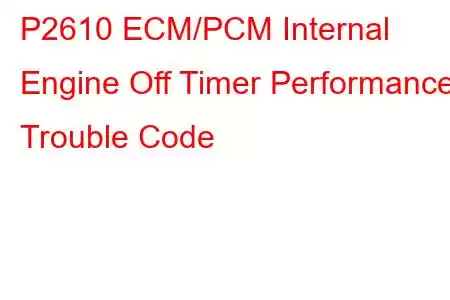Home » P2600-P2699 Codes » P2610 P2610 ECM/PCM Internal Engine Off Timer Performance
OBD-II Trouble Code Technical Description
ECM/PCM Internal Engine Off Timer Performance
What does that mean?
This diagnostic trouble code (DTC) is a generic powertrain code, which means that it applies to OBD-II equipped vehicles (Ford, GMC, Chevrolet, Subaru, Hyundai, Dodge, Toyota, etc.). Although generic, the specific repair steps may vary depending on make/model.
When I encounter a stored code P2610, it tells me that a malfunction has occurred, in the engine control module (ECM) or powertrain control module (PCM), concerning an inability to determine whether or not the engine has been shut off; and more specifically for how long the engine has been shut off.
The engine controller, whether it is referred to as an ECM or a PCM, uses input signals from the engine to determine whether or not the engine is running. Among the engine control indicators used to accomplish this are engine RPM (crankshaft position sensor), fuel pressure sensor, and primary ignition system voltage. If the ECM/PCM fails to detect a signal from one of these (or any one of a number of other) indicators signifying that the engine has been shut off, when switched (present only when the ignition switch is placed in the on position) voltage is not detected, it may not discern that the engine has been shut off.
The ECM/PCM internal engine off timer is critical to monitoring ignition cycles which help to calculate fuel delivery and ignition timing, as well as transmission shift patterns. If the ECM/PCM fails to declare the engine shut off and begin monitoring time between ignition cycles, a code P2610 will be stored and a malfunction indicator lamp may be illuminated. Typically, multiple ignition cycles (with a failure) will be required for malfunction indicator lamp illumination.
Symptoms & Severity
Since so many underlying factors depend upon ECM/PCM internal engine off timer performance, this code should be addressed with some degree of urgency.
Symptoms of a P2610 code may include:
Initially, no obvious symptoms will likely appear Diminished engine performance Decreased fuel efficiency Eventually, engine drivability symptoms may also be exhibitedCauses
Potential causes for this code to set are:
ECM/PCM programming errors Defective ECM/PCM Open or shorted wiring or connectors Faulty crankshaft position sensor (CPS) or shorted CPS wiringDiagnostic and Repair Procedures
A good starting point is always to check for technical service bulletins (TSB) for your particular vehicle. Your issue may be a known issue with a known fix put out by the manufacturer and can save you time and money during diagnosis.
In order to diagnose a stored code P2610, you will need a diagnostic scanner, a digital volt/ohmmeter (DVOM), and a reliable vehicle information source (such as All Data DIY).
If there are one or more CPS codes present, diagnose and repair those before attempting to diagnose a stored P2610.
You will be well served to connect the scanner to the vehicle diagnostic connecter at this time. Retrieve all stored codes and freeze frame data and write this information down; it may be helpful, especially if the P2610 proves to be an intermittent code. Now, clear the codes and test drive the vehicle to see if the P2610 is reset. If it is reset, reconnect the scanner and observe CPS and engine RPM data using the data stream display. Focus on CPS and RPM readings with the key on and the engine off (KOEO). If engine RPM readings indicate anything other than 0, suspect a defective CPS or shorted CPS wiring. If CPS and engine RPM data appears normal, continue with the diagnostic process.
Use the DVOM to observe ignition coil primary voltage with the ignition in the off position. If ignition coil primary
Read: 22


